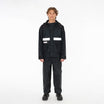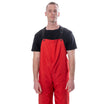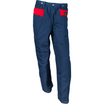Working in the construction industry involves numerous challenges, exacerbated by unfavorable weather conditions like rain. Whether you're overseeing a large-scale commercial project or simply working on an individual residential build, there's no avoiding the unpredictability of weather. When the skies open up, it's paramount to have quality rain gear to keep you dry and functional throughout your workday.
This article will delve into the importance of selecting the right rain gear for construction work. It will not only increase your productivity but also ensure your safety during stormy weather. We will explore the diverse types of rainwear available in the market, the future of rainwear technology, and how to select the most suitable rain gear based on your work environment and personal preferences.
After all, when you're better protected against the elements, you can concentrate fully on the task at hand and deliver your best performance, regardless of the weather forecast. Let's dive in!
Understanding the Importance of Rainwear for Construction
The construction industry, known for being labor-intensive, often requires individuals to work in challenging and harsh environments. Rain and wet conditions are common issues faced by these individuals, increasing the risk of accidents and injuries. Understanding the dynamic role of rainwear in maintaining safety and productivity under such circumstances is paramount. This knowledge not only optimizes work efficiency but also ensures safer working conditions for construction workers.
Construction Industry Fatalities
The perilous nature of the construction industry is hardly a secret, with data from the U.S. Bureau of Labor Statistics revealing how one in every five workplace deaths happens within the construction sector. Back in 2015 alone, the construction industry recorded a staggering 937 fatal work injuries. These alarming numbers underline the importance of stringent safety measures to avert needless accidents and deaths.
Unfortunately, working in damp and slippery conditions brought on by rain adds an extra layer of complexity to construction safety. Rain can make surfaces, particularly rooftops and scaffolds, dangerously slick. This further heightens the risk of fatal falls, which already stand as the leading cause of death in the construction industry.
Importance of Proper Rain Gear
Against this backdrop, investing in appropriate rain gear becomes less of a choice and more of a necessity. Quality rainwear serves as the frontline of defense against adverse weather conditions, especially rain, for construction workers. It not only keeps the wearer dry but also helps maintain body heat and prevent hypothermia during cold, wet days.
Remember, regular clothing, no matter how thick or layered, is hardly a match for prolonged exposure to rain. Construction workers need commercial-grade rainwear crafted explicitly to withstand the rigors of their work environment.
Nevertheless, the trickiest part is that not all rainwear is built alike. There is a sea of options available, and choosing the right one can be daunting. Yet, success lies in finding gear that blends durability, comfort, and waterproof capabilities.
After all, a worker's ability to carry out tasks effectively relies heavily on their physical comfort. Ill-fitted or uncomfortable rainwear could hamper mobility and work efficiency. In contrast, comfortable, durable, and waterproof rain gear, as highlighted in our article on Essential Rain Gear for Construction, can enable workers to perform at their best, irrespective of the weather.
In short, understanding the importance of quality rainwear for construction work and investing in the right gear can significantly decrease workplace fatalities and accidents, especially during rainy weather. This contributes to the creation of a constant, safe, and productive work environment, come rain or shine.
Assessing the Different Types of Rainwear
Rainy days call for sturdy rainwear that will help you stay dry and comfortable. But with the sea of options available out there, finding the right one can seem like an impossible task. Fret not! This article breaks down the different types of rainwear to consider when preparing for a precipitation-filled day, from waterproofing properties to breathability, insulation, and high visibility.
Waterproofing Properties
The crux of any rainwear is its waterproofing ability. A common favorite in this aspect is Polyvinyl Chloride (PVC), acclaimed for its extreme waterproofing properties. It's the material of choice for fishing rain gear, ensuring the wearer remains dry despite prolonged exposure to harsh rain. If you're looking for an everyday jacket for casual drizzles, the classic rubber raincoat might be the perfect fit.
Breathability
Even with the most stellar waterproofing, if your rain gear doesn't breathe, you'll end up sweating inside it. This kind of gear, particularly non-breathable ones like rubber, can result in the wearer getting wet—not from rain, but from sweat. The best rain gear successfully marries the waterproofing and breathability aspects, providing a dry yet comfortable experience regardless of the intensity of the downpour.
Insulation
For those venturing into chillier climates with potential for rain, insulation is key. Consider a 2-layer design, like a ski jacket, that contains insulation in between the waterproof outer and the lined inside. This can keep you both snug and dry when the temperature dips. Remember, not all rainwear offers insulation, so be sure this is a listed feature if you're shopping for cold-weather gear.
High Visibility
If you'll be working on a construction site or need to navigate your way through a foggy day, high-visibility rain gear should be your go-to. Work rain jackets, hoodies, shirts, pants, and overalls are engineered to protect individuals working in moist, yet low-visibility conditions. These distinctive pieces often display reflective properties to ensure your safety while navigating the weather.
You can equip yourself with suitable rainwear using our Waterproof and Tear-Resistant Rain Gear guide. With rainwear tailored to your preferences, you'll be ready to tackle any wet environment without dampening your spirit.
Specific Rain Gear Recommendations
Getting caught without proper protection during a downpour isn't just inconvenient; it could spell disaster during an outdoor adventure or a tough day at the construction site. Luckily, several brands provide outstanding rain gear, combining waterproof qualities with breathability and style for the ultimate weather-proof package. So, let's get straight to the point and take a glance at some of the best rain gear recommendations that have earned their place in the spotlight.
Frogg Toggs Men's Pro Lite Rain Suit:
If you're looking for comprehensive coverage from the elements, this suit is a solid choice. Besides its stellar waterproof capabilities, the suit is incredibly lightweight, making it a perfect choice for those who value both comfort and protection.
Patagonia Granite Crest Rain Jacket:
This is a standout model with a focus on environmental sustainability. Crafted from recycled polyester, this jacket not only resists water but is also strong enough to withstand windy situations.
The North Face Dryzzle Futurelight:
This one's made with cutting-edge fabric technology, assuring the user a garment that's not just waterproof but highly breathable. Whether you're hiking in the wild or facing a rainy workday, this jacket promises to keep you dry and comfortable.
REI Co-op Rainier Rain:
A classic in the rain gear line up, this jacket combines an affordable price point with high-level functionality, making it a favorite among outdoor enthusiasts.
Visp Rain Jacket:
This is the top contender for anyone who wants exceptional breathability. It boasts of an unprecedented MVTR (Moisture Vapor Transmission Rate) rating of 83,000, which is unparalleled in the industry.
These are just a few recommendations that combine raw performance with style and comfort. But, as always, you should choose a model that matches your specific needs and circumstances for the best results.
Speaking of requirements, construction workers demand something extra from their rain gear. It's not just about staying dry; their gear needs to withstand the rough and tumble of their working conditions. So, if you're in the construction field and searching for rain protective equipment, you might want to look at these durable rain jackets for construction workers specifically designed to meet your unique needs.
The Future of Rainwear Technology
Rain has always been an elemental force to be reckoned with – drenching clothes, dampening spirits, and turning bright sunny days into a soggy mess. It's an inconvenience we've all learned to deal with. However, with advancements in rainwear technology, harnessing something as vexing as rain has become less of a nuisance and more an opportunity to showcase innovation.
The outdoor gear industry, despite its perennial engagement with nature's whims, has been less than fleet-footed in the past when it comes to developing new rainwear technology. Adopting waterproof, breathable, comfortable, and most importantly, PFAS-free materials wasn't something that happened overnight. It took time to shift from the traditional oilskins and yellow waterproof cloaks to sophisticated clothing that optimally provides an answer to the water-repellence versus breathability conundrum.
Suffice to say, the industry's transformation has focused on creating gear that's not merely water-resistant but also ticks all the boxes for what an outdoor enthusiast considers essential – comfort, breathability, and sustainability. It wasn't an easy path, but the recent strides in rain gear technology are nothing short of revolutionary.
In essence, the future of rainwear technology lies in continuing to refine and redefine these standards. Products that embody these principles are no longer a luxury but a necessity for both casual consumers and outdoor professionals. The industry's trajectory indicates a burgeoning need to address these evolving consumer expectations while also maintaining a careful balance with sustainability and environmental consciousness.
The advancements made thus far have indeed been commendable – especially in light of the Innovative Technologies in Rain Gear that are trailed to make a significant impact in 2023. These innovations promise to further elevate the performance and functionality of rain gear, transforming outdoor experiences.
In essence, rain is no longer a bugbear to endure but a challenge to embrace. It is now possible to feel the rain without getting soaked. After all, as they say, there's no such thing as bad weather, only unsuitable clothing. With the future of rainwear technology brimming with potential, the industry stands poised to make this adage a tangible reality.
Conclusion
Navigating through the complexities of choosing the right rain gear for construction work can seem daunting. However, when you prioritize vital factors such as waterproofing, breathability, insulation, and high visibility, the task becomes simpler. And while technological advancements promise to revolutionize rain gear even further in near future, the tried and tested solutions of today can significantly assist in safeguarding construction workers from weather extremities.
Among such solutions, Hurricane Raingear stands as a shining example with its exclusive blend of functionality, comfort, and durability. Handcrafted in the Pacific Northwest with 100% North American materials, the products proudly uphold the quality and trust associated with the brand.
To sum it up, investing in high-quality rain gear is a non-negotiable, life-saving decision for those in the construction industry. Rain or shine, the right rain gear will keep you comfortably secured, ensuring you can focus on completing the work at hand effectively. With the right information and careful consideration, one can make an informed choice about the appropriate rainwear that promises comfort, safety, and durability, just like Hurricane Raingear does!
Frequently Asked Questions
-
What are the essential features to look for in rain gear for construction work?
Essential features to look for in rain gear for construction work include waterproof and breathable materials, durable construction, adjustable cuffs and hems, and multiple pockets for storage.
-
Should I choose a rain jacket or a full rain suit for construction work?
The choice between a rain jacket and a full rain suit depends on personal preference and the nature of the work. A rain suit provides full-body protection, while a rain jacket offers flexibility and versatility. Consider the specific demands of your construction work before making a decision.
-
Are there any specific safety considerations when choosing rain gear for construction work?
Yes, safety should be a priority when choosing rain gear for construction work. Look for high-visibility options, reflective strips, and the ability to accommodate additional safety gear such as hard hats and boots.
-
How do I ensure the proper fit of rain gear for construction work?
To ensure the proper fit of rain gear for construction work, refer to the manufacturer's size guide and take accurate measurements. Consider the range of motion required for your work and choose gear that allows freedom of movement without being overly loose or tight.
-
What are some recommended brands for rain gear in construction work?
Some recommended brands for rain gear in construction work include Carhartt, Columbia, Helly Hansen, Marmot, and The North Face. These brands are known for their durable and high-quality rain gear.
























Leave a comment
This site is protected by hCaptcha and the hCaptcha Privacy Policy and Terms of Service apply.